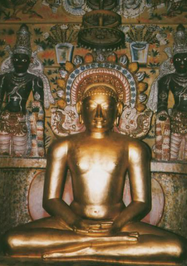Kunthunath: Difference between revisions
From Tamil Wiki
Former-users (talk | contribs) m (→Mythology) |
Former-users (talk | contribs) No edit summary |
||
| Line 1: | Line 1: | ||
{{Ready for review-en}} | |||
{{Read Tamil|Name of target page=குந்துநாதர்|Title of target page=குந்துநாதர்}} | {{Read Tamil|Name of target page=குந்துநாதர்|Title of target page=குந்துநாதர்}} | ||
[[File:குந்துநாதர்.png|thumb|267x267px|Kunthunath]] | [[File:குந்துநாதர்.png|thumb|267x267px|Kunthunath]] | ||
Revision as of 10:16, 6 July 2022
Ready for review en
Please do not write any content below this line. This section is only for editing templates & categories.
இந்தப் பக்கத்தை தமிழில் வாசிக்க: குந்துநாதர்
Kunthunath was the seventeenth Tirthankara of Jainism. He is known as Siddha Purushar who was freed from the shackles of karma.
Mythology
Kunthunath was born to king Suryadevar and queen Shir Devi at Hastinapur in the Ikshvaku dynasty. In the north Indian language Kunthu means pile of nine gems(Navrathnas). Kundunath lived for 100,000 years and attained Moksha on Mount Sikarji.
Symbolism
- Body Color: Golden
- Symbol: Goat
- Tree: Tilak
- Height: 35 bows (105 meters)
- Hands: 140 hands
- Age at Salvation: 100,000 years
- First meal: Pudding served by Dharmamitra of Hastinapur
- Chief Disciples (Ganadharas): 35 (self-manifested)
- Yaksha: Gandharva Deva
- Yakshini: Goddess Jaya
Temples
- Digamber Jain Temple, Hastinapur, Uttar Pradesh
- Ganagitti Jain Temple, Hampi
- Jaisalmer Fort Jain Temples
- Kunthunathar Jain Temple, Karanthai, Tamil Nadu

